The oboe is a woodwind instrument that primarily appears in orchestras and classical music. It dates back to the 17th century when musicians first used it in the French courts. While the early oboe had only two keys, the modern instrument is significantly more complex—as you’ll see.
If you’re learning how to play the oboe, one of the first things you’ll need to do is familiarize yourself with the instrument’s various parts. Understanding how the oboe is built will help you understand how to best play it and ensure you know how to care for it.
In this guide, we give you a detailed anatomy of the oboe.
Anatomy of the Oboe

The oboe is made up of three main parts:
- upper secion (or joint)
- lower section (or joint)
- bell
Each of these parts is connected together by tenons which are made of cork and help to create a tight seal between each of the parts.
For the oboe to play correctly, these parts must be fit together and aligned precisely and if they aren’t you might not be able to play all the notes!
In addition to these main parts, many smaller pieces work together harmoniously to create the oboe’s desired pitch and sound.
Let’s take a look at each one individually.
The Reed
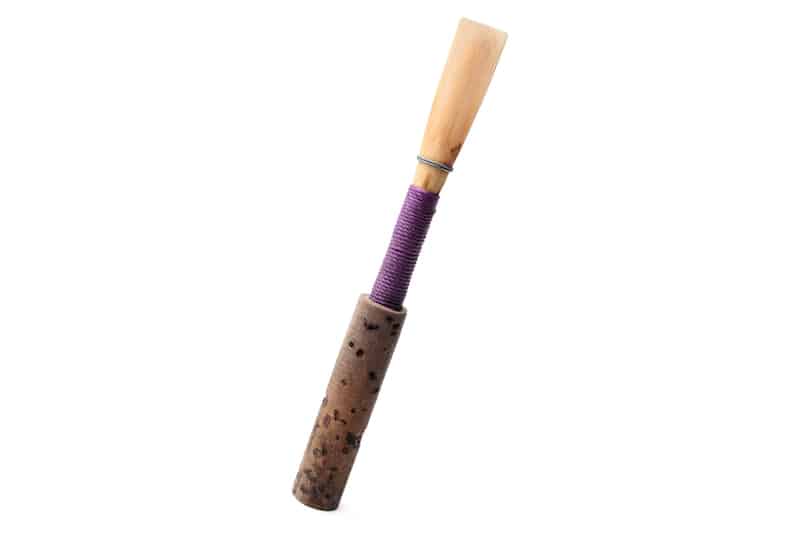
The oboe is a type of double-reed instrument, unlike the clarinet or saxophone which are both single-reed instruments.
(Fun fact: The bassoon is the only other double-reed instrument in the standard modern orchestra).
The reed is made of two pieces of cane, which are pressed tightly together and inserted into the oboe’s reed socket, a piece that holds the reed in place.
The sound on a double reed instrument is created by blowing air in between the two pieces of cane which cause them to vibrate against each other and creates the sound.
The quality of the oboe reed can make a big difference when playing the instrument, and some professional oboists insist on making their reads to meet their precise specifications.
The reed also influences the instrument’s tone and if a reed is not made properly or cracks if can affect the pitch of the notes produced.
Staple
The staple is the part that helps direct the player’s airflow and vibrations into the body of the oboe.
The staple may sometimes be referred to as a bocal, similar to a bassoon’s.
Like the reed, the staple can significantly impact the oboe’s sound with its materials, size, and shape.
Upper Section
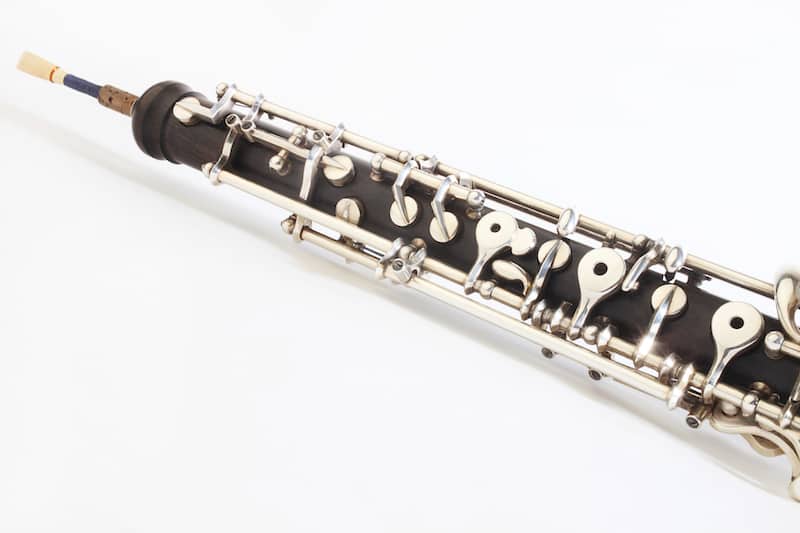
The next piece of the oboe is the upper section or top joint which is the part that connects the reed to the lower section of an oboe.
It’s the part that the oboist grips with their left hand and has tone holes that are covered or left uncovered which can determine the pitch of the note that sounds.
This part of the oboe is very narrow, with an internal diameter of only four millimeters.
It funnels the air blown through the staple down the body of the oboe.
Tone Holes and Keys
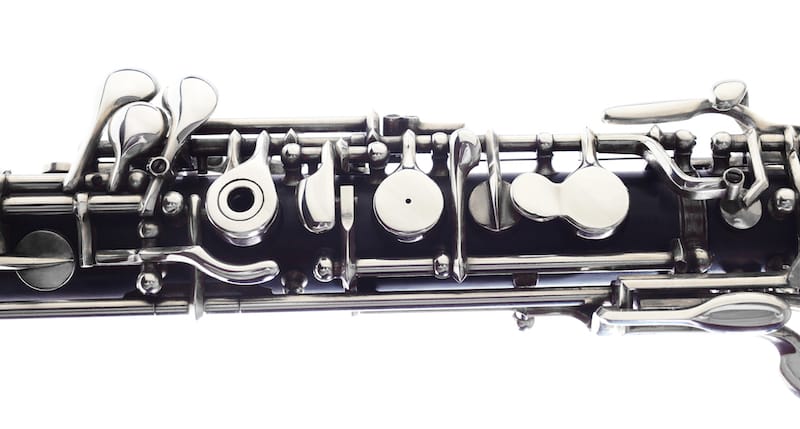
On the upper and lower sections of the oboe, you’ll find tone holes that are drilled into the body of the oboe.
Most oboes have 23 tone holes which are either left open or closed.
Depending on what combination of tone holes the musician covers or uncovers, will allow them to play different pitches of notes.
But, rather than covering the tone hole with the pad of the finger (like on a recorder) oboe tone holes are covered with keys.
The musician pushes down on the key, which has a felt or cork pad underneath it, to ensure the tone hole is completely sealed and that no air can get out.
Octave Keys
Another important piece of an oboe is the octave keys. These a keys that allow the oboe to play in different octaves.
Most oboes have two octave keys that allow the musician to produce notes one to two octaves higher.
But, some oboes also have a third-octave key on the back of the top joint.
Tenons
Between each of the main parts of an oboe, you’ll find the tenons.
Tenons are typically made of cork and are there to help connect the parts and ensure a complete seal so that no air leaks out.
The Lower Section
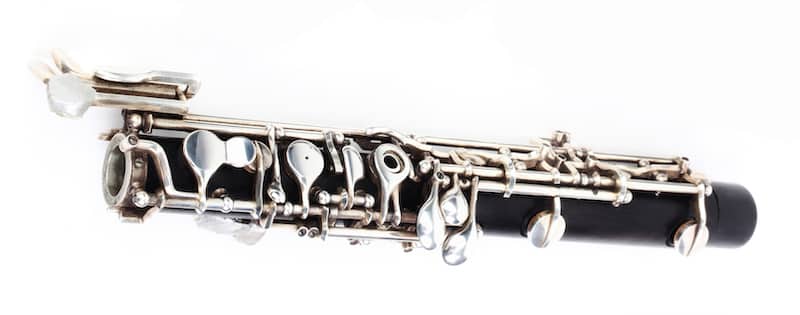
Beneath the upper section is the lower section or bottom joint.
As you go down the body of the oboe, it becomes progressively wider as the interior shape of the oboe is a cone.
The lower section has more keys
Bridge Keys
To allow you to play certain notes, you’ll need to utilize the complex system of rods and keys all along the body of the oboe.
One very important part is the bridge keys which allow you to cover tone holes on different sections of the oboe by playing a key on another section.
It creates a bridge between the two parts which is where it gets its name from.
The mechanism needs to be perfectly aligned between the joints for the oboe to play optimally.
If you don’t have it lined up correctly, you won’t be able to play certain notes so it’s really important to get it right.
Another thing to mention is that the rods and keys on an oboe are very fragile and it’s important to keep your oboe carefully stored correctly in your case when not in use!
They can bend and break very easily which can impede the oboe’s functionality, so don’t twist or push on them too hard.
If you’re having trouble fitting the oboe’s joints together, use some cork grease first.
Bell
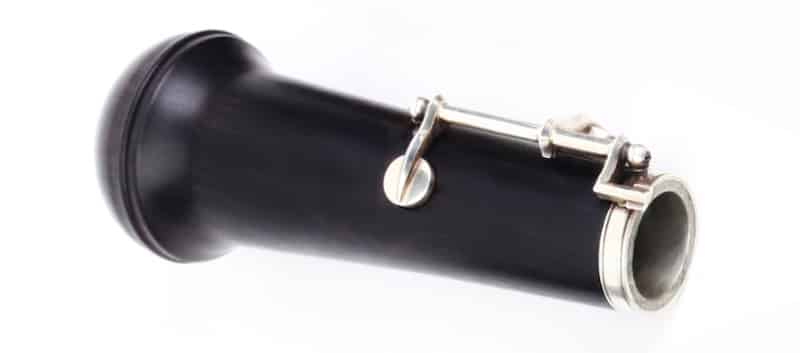
And finally, we have the bell is the very bottom part of the oboe, that attaches to the lower section.
The oboe’s bell is flared (much like a trumpet) which helps to amplify and balance the sound and tone of the sound created as it leaves the body of the oboe.
However, note that there are many different types of bells and the length, weight, and flare of the bell can all impact the oboe’s final sound.
It’s essential never to chip or dent the bell, as this can affect the oboe’s definitive sound. Be especially careful when you’re removing it from the case.
Conclusion
As you can see, the oboe is a complex and unique instrument. Although less recognizable than its woodwind counterparts like the flute or clarinet, it plays an integral role in many orchestras.
You’ve likely heard it played in various classical music songs.
There are many oboe concertos worth listening to.
Whether you play the oboe yourself or admire the instrument, you may be surprised to realize how complex this woodwind is—as the above guide makes clear.
The many complicated mechanisms needed to create the oboe’s sound make this instrument all the more impressive.

